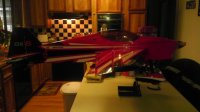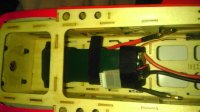Thanks Ground Hog. Got my throws sorted out. Doing the CG now and If Ive done that right which I may not have, because while sitting upright on the machine the battery was dang near to the back of the firewall. Don't think thats right. See pic below... May I ask those of you that have thi s bird where did your cg end up. I know it will be different from plane to plane, but I have a feeling my is way wrong. The manual say's
Quote:
Balancing: The Vyper can use a wide range of center-of-gravity locations. For your maiden, we suggest
a more forward CG location, since you can always move your CG rearward to suit your flying style if
necessary.
For maiden and precision flight - 170-180 mm from leading edge of wing at root
When trimming your CG, keep in mind that a “neutral” CG (one with which you can roll the airplane
inverted and the airplane neither climbs nor dives) is good for 3D aerobatics, but a more forward CG (one
with which you must hold some “down” elevator to keep the airplane flying straight while inverted) is often
better for precision flight and is much easier to land gracefully.
The only part that Im not quite sure of is "from leading edge of wing at root" I just marked out to 180mm on the ruler of my cg machine and placed the plane on top as depicted in the pic <--- LOL Im a poet and didn't even know it. BaHaHa. Seriously though I do need a bit more advice fella's. So close to putting this bad boy in the air. :flyer:
View attachment 31881


